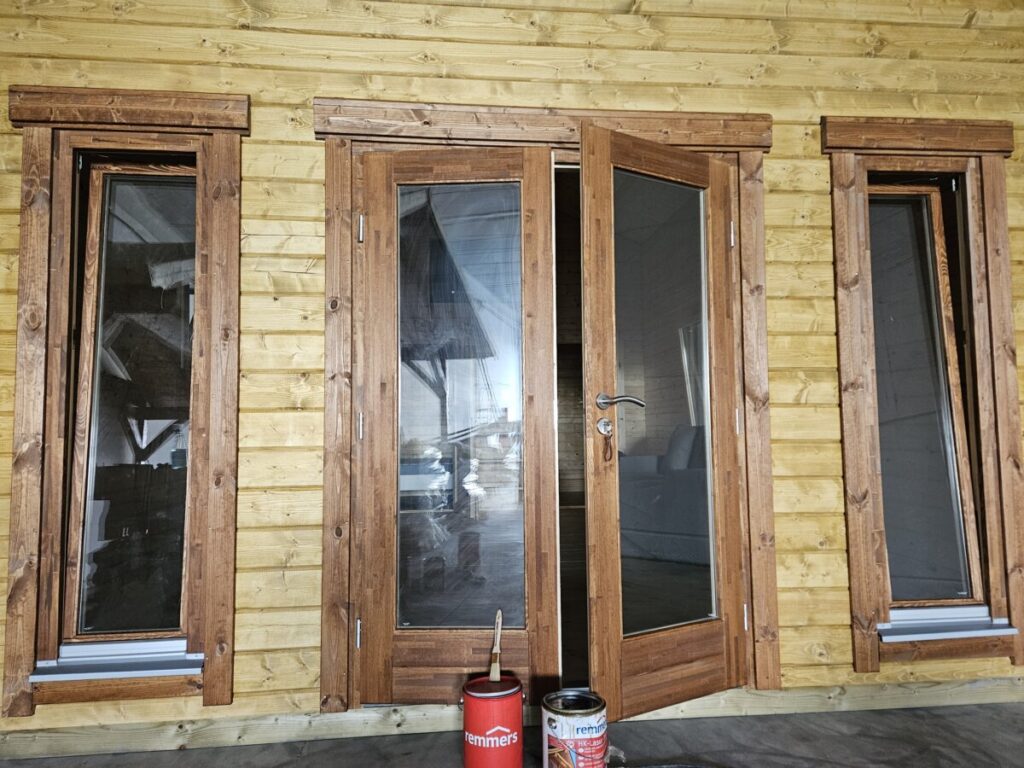All our log cabins have factory treated floor joists and decking boards. The other timber components should be treated with a wood preservative after the garden building has been assembled. If you buy a garden building in our online shop, you can add wood stain and wood oil from the German company Remmers. We partner with Remmers because their products offer superior durability and quality. In this article, we will explain how to use their products, but the rules also apply to comparable products from other manufacturers. In addition to our general advice, always read the manufacturer’s instructions before using any product.

Untreated wood is susceptible to decay and pests if it is exposed to moisture, and to UV weathering if it is exposed to direct sunlight. It can be protected by various wood preservatives.
Paint forms a solid barrier on top of the wood, completely covering its colour. It is waterproof, creates a uniform surface and can be used as an interior or exterior coating. However, its integrity needs to be checked regularly. If the paint cracks, the wood underneath is no longer protected and will warp, causing more cracks in the paint.
Varnish is a transparent or semi-transparent coating that protects wood from scratches, stains, and liquids and enhances its natural beauty. Varnish does not work well outdoors and is more suitable for indoors.
Stain is a semi-transparent coating that enhances the natural characteristics of wood. Rather than creating a protective layer on top of the wood, like paints and varnishes, stains soak into the wood and protect it from within. It protects against moisture and UV rays and cannot crack.
Oil is also absorbed by the wood, improving its appearance and performance. Over time, wood loses its natural oils and becomes brittle. Applying wood oil prevents damage and wear. It is most commonly used indoors.
Most wood preservatives must be applied twice, and you must ensure that all wood surfaces are evenly coated. This makes painting very time-consuming. We therefore recommend using quality products such as Remmers wood stains. They perform better and last longer than cheaper products. This will save you time and money in the long run.
How often you need to reapply the wood preservative depends not only on the quality of the wood preservative, but also on its exposure to the elements. One side of the garden building will usually be exposed to more rain or sunlight and will therefore require more maintenance.
We recommend using Remmers Wood Stain for the exterior and Remmers Wood Oil for the interior. You will need a stick to stir the stain occasionally and masking or painter’s tape to cover areas that are not to be stained.
To apply the stain, use either 80-100 mm brush and 20-30 mm brush for window and door frames and other intricate areas.
Wood oil can be applied with a brush, roller, cloth or by spraying. Short-pile microfibre rollers are ideal for large areas such as walls and floors, while a smaller wood oil brush can be used for corners. You can also use a lint-free cloth, but this will typically require three to four coats of oil. However, you will need a cloth to wipe up any excess oil when brushing or rolling. Spraying wood oil is possible but complicated and should only be done by a professional.
We know that the weather can be unpredictable at times, but we recommend that wooden buildings are assembled, and exterior wood preservative applied during warm, dry weather. If the wood gets wet during assembly, wait until it is completely dry before applying the wood preservative.
Remmers Wood Stain can be applied directly without a primer, as its formula contains both stain and primer. Like most wood stains, it requires two coats for optimum performance. If you are using a pigmented stain, stir every 30 minutes to prevent the pigments from sinking to the bottom. Apply the stain evenly and be sure to tape off the glass if you are staining the windows.
During and after assembly, try to keep the log cabin floor clean by not walking on it with your shoes, as untreated wood can easily stain. Start by treating the floor wearing clean shoes or socks, starting at the back of the room and working towards the door. Be sure to wipe off any excess wood oil to avoid an uneven finish and long drying times. When the floor is completely dry, treat the walls and ceiling with Wood Oil.
If you have any questions about our products and how to maintain them, browse through our blog or contact us by email or phone.